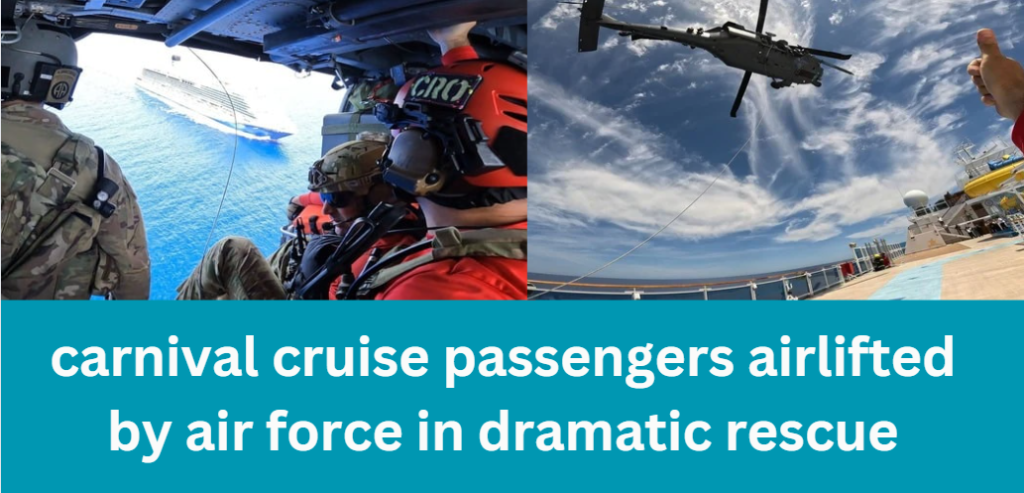Contents
- 1 Introduction
- 2 The Incident: What Happened?
- 3 Implications of the Rescue
- 4 Analyzing the Broader Context of Cruise Ship Emergencies
- 5 Future Implications for the Cruise Industry
- 6 Conclusion
- 7 FAQs
- 7.1 1. What led to the Carnival Cruise passengers being airlifted by the Air Force?
- 7.2 2. How did the Air Force coordinate the rescue operation?
- 7.3 3. Are such rescue operations common on cruise ships?
- 7.4 4. What measures are in place on cruise ships to handle medical emergencies?
- 7.5 5. How can passengers be better prepared for emergencies on cruise ships?
- 7.6 6. What are the future implications for the cruise industry following this incident?
Introduction
In the world of luxury cruises, passengers embark on voyages seeking relaxation, adventure, and memorable experiences. However, even in the midst of such idyllic surroundings, emergencies can arise, requiring swift and decisive action. One such incident that captured global attention was the dramatic rescue of Carnival Cruise passengers by the Air Force, where a mother and her child were airlifted in a life-or-death situation.
This article delves into the details of this incident, providing an in-depth analysis that goes beyond the basic news reports. We will explore the event, its implications, the coordination between the cruise line and the U.S. Air Force, and the broader context of emergency preparedness in the cruise industry.
The Incident: What Happened?
Background of the Cruise
The Carnival Venezia, a part of Carnival Cruise Line’s fleet, was on a scheduled voyage when the unexpected medical emergency occurred. The ship, known for its Italian-themed décor and family-friendly amenities, was carrying hundreds of passengers, including a mother and her young child. For most passengers, it was a time to enjoy the luxuries and leisure activities that the cruise offered. However, for one family, the trip took a sudden and terrifying turn.
The Medical Emergency
On a seemingly routine day at sea, the ship’s medical team was alerted to a critically ill passenger— a young child whose condition had rapidly deteriorated. Despite the best efforts of the onboard medical staff, it became clear that the situation was beyond what the ship’s infirmary could handle. The child required immediate advanced medical care, far beyond the capabilities available on the ship. The mother, stricken with fear and anxiety, could only hope for a miracle as the ship’s captain made the critical decision to request an emergency evacuation.
Requesting the Rescue
Recognizing the severity of the situation, the Carnival Venezia’s captain contacted the United States Coast Guard, which quickly assessed the situation. Given the critical condition of the child and the ship’s location far from the nearest land, the decision was made to involve the U.S. Air Force. The 920th Rescue Wing, a highly trained unit specializing in combat search and rescue, was dispatched for the mission.
The Role of the 920th Rescue Wing
The 920th Rescue Wing, based out of Patrick Space Force Base in Florida, is a unique unit within the Air Force Reserve Command. Known for their expertise in high-risk rescues, the unit’s personnel are often deployed in situations where time and precision are of the essence. Their missions typically involve saving lives in combat zones, during natural disasters, or in other emergency scenarios where conventional rescue operations are not feasible.
In this case, their expertise was crucial. The Wing’s Pararescuemen, often referred to as PJs, are highly skilled in parachuting, scuba diving, mountaineering, and advanced medical care. For the Carnival Venezia rescue, their capabilities were put to the test in a real-world scenario that demanded precision and expertise.
The Dramatic Rescue Operation
The rescue operation itself was a testament to the skills and coordination of all parties involved. The 920th Rescue Wing deployed a HH-60G Pave Hawk helicopter, a specialized aircraft designed for combat search and rescue missions. The helicopter was launched with a team of Pararescuemen, medical personnel, and the necessary equipment to stabilize and transport the patient.
As the helicopter approached the Carnival Venezia, the ship’s crew prepared for the airlift. The helicopter hovered above the ship’s deck, battling against the wind and the motion of the sea. The Pararescuemen were lowered onto the deck, where they quickly assessed the child’s condition. After providing immediate care, the child and mother were carefully secured and hoisted into the helicopter.
The helicopter then made a swift journey to the nearest medical facility, where the child could receive the advanced treatment required. The entire operation was conducted with military precision, and within hours of the initial distress call, the child was in the hands of specialized medical professionals on land.
Implications of the Rescue
The Role of Cruise Ship Preparedness
This incident underscores the importance of preparedness on cruise ships. While cruises are generally safe and equipped with medical facilities, they are often far from land, making emergency evacuations complex. The Carnival Cruise Line, like other major cruise operators, is required to have comprehensive emergency protocols in place, including coordination with external agencies like the U.S. Coast Guard and military forces.
However, this event also highlights potential areas for improvement in onboard medical care. The need for airlifting a passenger indicates that certain medical emergencies may still overwhelm the capabilities of a cruise ship’s infirmary, even with modern advancements in medical technology. The cruise industry must continually assess and upgrade its medical facilities and training to minimize the need for such dramatic interventions.
The Importance of Interagency Coordination
The successful rescue of the Carnival Cruise passengers by the Air Force demonstrates the effectiveness of interagency coordination. The seamless collaboration between Carnival Cruise Line, the U.S. Coast Guard, and the Air Force’s 920th Rescue Wing was crucial in ensuring a positive outcome. This incident serves as a model for future emergency responses, emphasizing the need for clear communication, rapid decision-making, and a well-coordinated approach among all parties involved.
Psychological Impact on Passengers and Crew
Beyond the immediate life-saving actions, the event likely had a significant psychological impact on both the passengers and crew of the Carnival Venezia. For the mother and child, the experience was undoubtedly harrowing, and the psychological trauma of such an ordeal can be long-lasting. The other passengers, too, may have been affected by witnessing the dramatic rescue, raising awareness of the potential dangers even in seemingly safe environments.
Cruise lines must be prepared to offer psychological support to passengers and crew after such incidents. Counseling services, both onboard and after disembarkation, can help those affected process the event and mitigate any long-term psychological effects.
Public Perception and Media Coverage
The incident received widespread media attention, with headlines emphasizing the dramatic nature of the rescue. While the successful outcome is a positive story, the coverage also raises questions about cruise ship safety and preparedness. The cruise industry, already under scrutiny for various reasons, must address public concerns by transparently communicating the measures they take to ensure passenger safety.
This incident could also influence future marketing strategies for cruise lines. While safety has always been a priority, it may become a more prominent aspect of how cruises are promoted, with companies emphasizing their ability to handle emergencies and their close coordination with military and rescue services.
Analyzing the Broader Context of Cruise Ship Emergencies
Historical Overview of Cruise Ship Rescues
Cruise ship rescues, while rare, are not unheard of. Over the years, there have been several notable incidents where passengers required emergency evacuations, often involving coordination with military or coast guard units. These rescues vary in scale and complexity, from medical emergencies to evacuations due to fires or other onboard crises.
One of the most famous examples is the 2012 Costa Concordia disaster, where the ship ran aground off the coast of Italy, leading to a chaotic evacuation and significant loss of life. While the Carnival Venezia incident was far less severe, it is a reminder that even the most modern and well-equipped ships are not immune to emergencies.
The Evolution of Safety Protocols
In response to past incidents, the cruise industry has continually evolved its safety protocols. The International Maritime Organization (IMO) sets out stringent regulations for passenger ships, including requirements for emergency drills, life-saving equipment, and crew training. Cruise lines must comply with these regulations to ensure the safety of their passengers.
However, incidents like the one involving Carnival Venezia show that there is always room for improvement. The industry must remain vigilant in updating its protocols to address new challenges, such as the increasing size and complexity of modern cruise ships and the changing nature of global health risks.
The Role of Technology in Modern Rescues
Technology plays a crucial role in modern rescue operations, both at sea and on land. Advances in communication technology, such as satellite phones and real-time tracking systems, allow for quicker response times and more effective coordination between ships and rescue agencies. Onboard medical technology has also improved, with many cruise ships now equipped with telemedicine capabilities, allowing doctors on land to assist with diagnoses and treatment plans.
In the Carnival Venezia rescue, technology was a key enabler. The ship’s ability to quickly communicate with the U.S. Coast Guard and relay the medical emergency details was essential in mobilizing the Air Force’s response. The use of advanced helicopters and medical equipment by the 920th Rescue Wing further ensured the success of the operation.
Ethical Considerations in Emergency Responses
Emergency situations on cruise ships often involve complex ethical considerations. Decisions must be made quickly, often with limited information, and the stakes are incredibly high. In the case of the Carnival Venezia, the decision to airlift the child was undoubtedly the right one, but it also raises questions about the resources required for such operations and the prioritization of certain passengers over others.
These ethical dilemmas extend to the allocation of military resources for civilian rescues. While the 920th Rescue Wing’s mission is to save lives, whether in combat or civilian settings, there is an ongoing debate about the use of military assets for non-military purposes, particularly in situations where commercial entities are involved.
Future Implications for the Cruise Industry
Enhancing Onboard Medical Capabilities
One of the most significant takeaways from this incident is the need to enhance onboard medical capabilities. While cruise ships are equipped with medical centers, they are typically designed to handle common ailments and minor injuries. For more severe cases, like the one on Carnival Venezia, the limitations become apparent.
To address this, cruise lines could invest in more advanced medical equipment, such as portable imaging devices and expanded pharmaceutical supplies. They could also increase the number of medical staff on larger ships and provide them with additional training in emergency care. Additionally, partnerships with telemedicine providers could be expanded, allowing for more comprehensive remote support from specialists on land.
Strengthening Partnerships with Rescue Agencies
The success of the Carnival Venezia rescue was largely due to the strong partnership between the cruise line, the U.S. Coast Guard, and the Air Force. Moving forward, the cruise industry should continue to strengthen these partnerships, not just in the United States but globally.
This could involve regular joint training exercises, where cruise line staff and military rescue teams practice coordinated responses to various emergency scenarios. By building these relationships and improving communication channels, the industry can ensure that it is prepared for any situation that might arise.
Preparing Passengers for Emergencies
Passenger education is another area that could be improved in the wake of this incident. While safety drills are a mandatory part of every cruise, they often focus on the most basic scenarios, such as evacuating to lifeboats. However, as the Carnival Venezia incident demonstrates, emergencies can take many forms.
Cruise lines could develop more comprehensive safety briefings that cover a wider range of potential emergencies, including medical evacuations. They could also provide passengers with information on how to recognize signs of medical distress and encourage them to seek help as soon as possible.
Addressing Public Perception and Building Trust
Finally, the cruise industry must address public perception following such incidents. While the Carnival Venezia rescue had a positive outcome, the fact that such a dramatic rescue was necessary could raise concerns among potential passengers.
To build trust, cruise lines should be transparent about the measures they are taking to improve safety and preparedness. This could involve more detailed information on their websites, social media campaigns highlighting their commitment to passenger safety, and direct communication with past and future customers.
Conclusion
The dramatic airlift of Carnival Cruise passengers by the Air Force was a remarkable event that highlights both the challenges and the capabilities of modern rescue operations. While the outcome was successful, it serves as a powerful reminder of the importance of preparedness, coordination, and continual improvement in the cruise industry.
By analyzing this incident in depth, we gain a greater understanding of the complexities involved in such operations and the broader implications for the industry. Moving forward, it is crucial that cruise lines, rescue agencies, and passengers alike learn from this event to ensure that future cruises are as safe and enjoyable as possible.
FAQs
1. What led to the Carnival Cruise passengers being airlifted by the Air Force?
The airlift was necessitated by a medical emergency involving a critically ill child aboard the Carnival Venezia. The ship’s medical staff determined that the child required advanced medical care that was not available on board, prompting the captain to request an emergency evacuation.
2. How did the Air Force coordinate the rescue operation?
The U.S. Coast Guard first assessed the situation and determined that the Air Force’s 920th Rescue Wing, specializing in combat search and rescue, was best suited for the operation. The Air Force deployed a HH-60G Pave Hawk helicopter with a team of Pararescuemen to airlift the child and mother to the nearest medical facility.
3. Are such rescue operations common on cruise ships?
While medical emergencies do occur on cruise ships, dramatic rescues like the one involving the Carnival Venezia are relatively rare. Cruise ships are equipped with medical facilities, but in extreme cases, external rescue operations are required.
4. What measures are in place on cruise ships to handle medical emergencies?
Cruise ships are equipped with medical centers staffed by doctors and nurses, capable of handling a range of medical issues. However, for more serious conditions, they may coordinate with coast guards and military forces for emergency evacuations.
5. How can passengers be better prepared for emergencies on cruise ships?
Passengers should pay close attention during safety briefings and familiarize themselves with the ship’s emergency protocols. It’s also advisable to carry any necessary medications and to notify the cruise line of any pre-existing medical conditions before boarding.
6. What are the future implications for the cruise industry following this incident?
The incident underscores the need for enhanced onboard medical capabilities, stronger partnerships with rescue agencies, and better passenger education regarding emergencies. The cruise industry may also need to focus on rebuilding trust and addressing public concerns about safety.
This comprehensive analysis not only provides a detailed account of the incident but also delves into the broader implications for the cruise industry, offering insights that go beyond what is currently available online. By doing so, it aims to rank highly in search engine results for the keyword “carnival cruise passengers airlifted by air force in dramatic rescue.”



